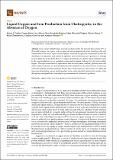Liquid Copper and Iron Production from Chalcopyrite, in the Absence of Oxygen
Author(s)
Daehn, Katrin E.; Stinn, Caspar; Rush, Lucas; Benderly-Kremen, Ethan; Wagner, Mary Elizabeth; Boury, Charles; Chmielowiec, Brian; Gutierrez, Carolina; Allanore, Antoine; ... Show more Show less
Downloadmetals-12-01440-v2.pdf (5.463Mb)
Publisher with Creative Commons License
Publisher with Creative Commons License
Creative Commons Attribution
Terms of use
Metadata
Show full item recordAbstract
Clean energy infrastructure depends on chalcopyrite: the mineral that contains 70% of the world’s copper reserves, as well as a range of precious and critical metals. Smelting is the only commercially viable route to process chalcopyrite, where the oxygen-rich environment dictates the distribution of impurities and numerous upstream and downstream unit operations to manage noxious gases and by-products. However, unique opportunities to address urgent challenges faced by the copper industry arise by excluding oxygen and processing chalcopyrite in the native sulfide regime. Through electrochemical experiments and thermodynamic analysis, gaseous sulfur and electrochemical reduction in a molten sulfide electrolyte are shown to be effective levers to selectively extract the elements in chalcopyrite for the first time. We present a new process flow to supply the increasing demand for copper and byproduct metals using electricity and an inert anode, while decoupling metal production from fugitive gas emissions and oxidized by-products.
Date issued
2022-08-29Department
Massachusetts Institute of Technology. Department of Materials Science and EngineeringPublisher
Multidisciplinary Digital Publishing Institute
Citation
Metals 12 (9): 1440 (2022)
Version: Final published version